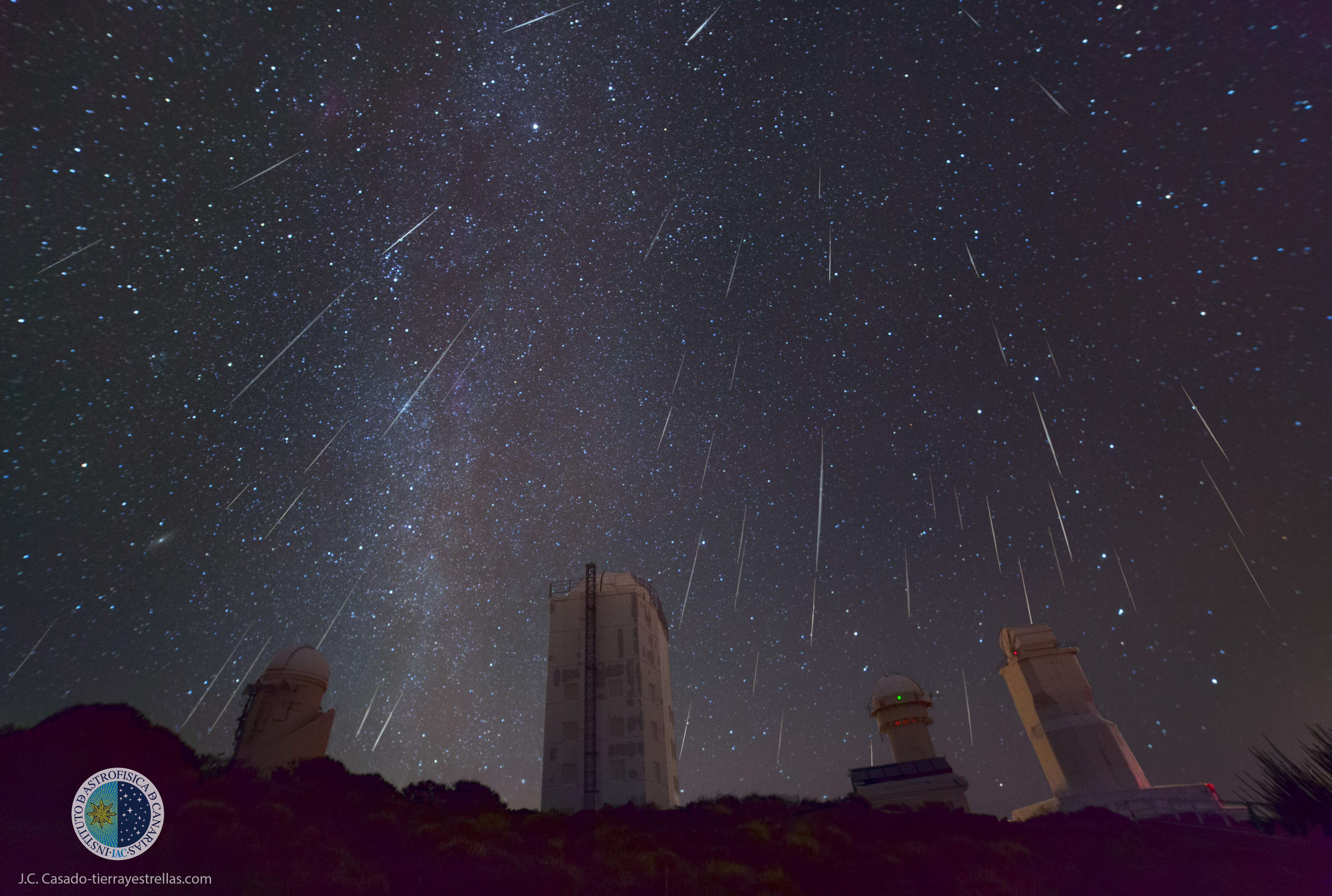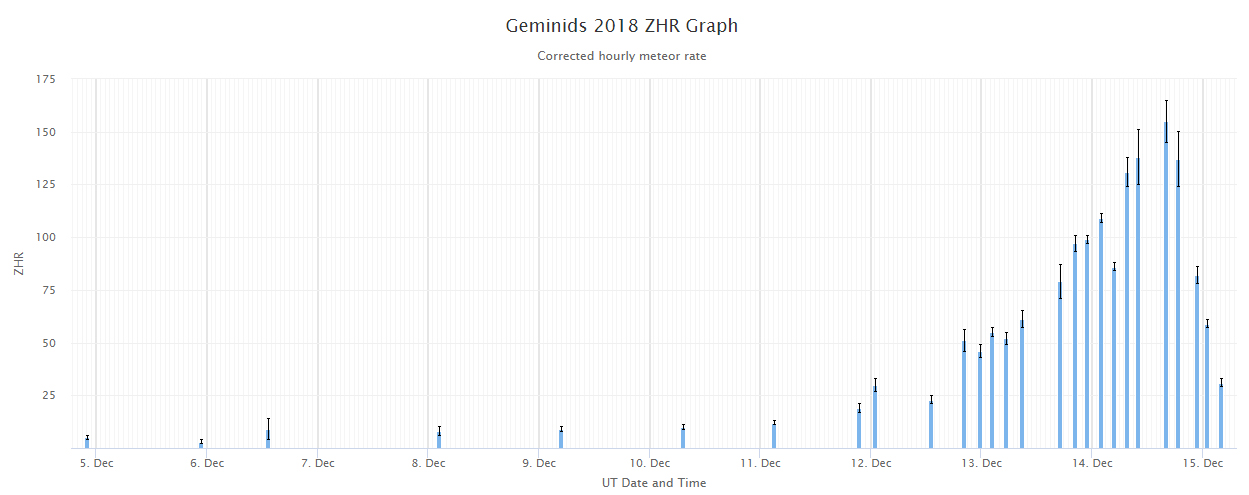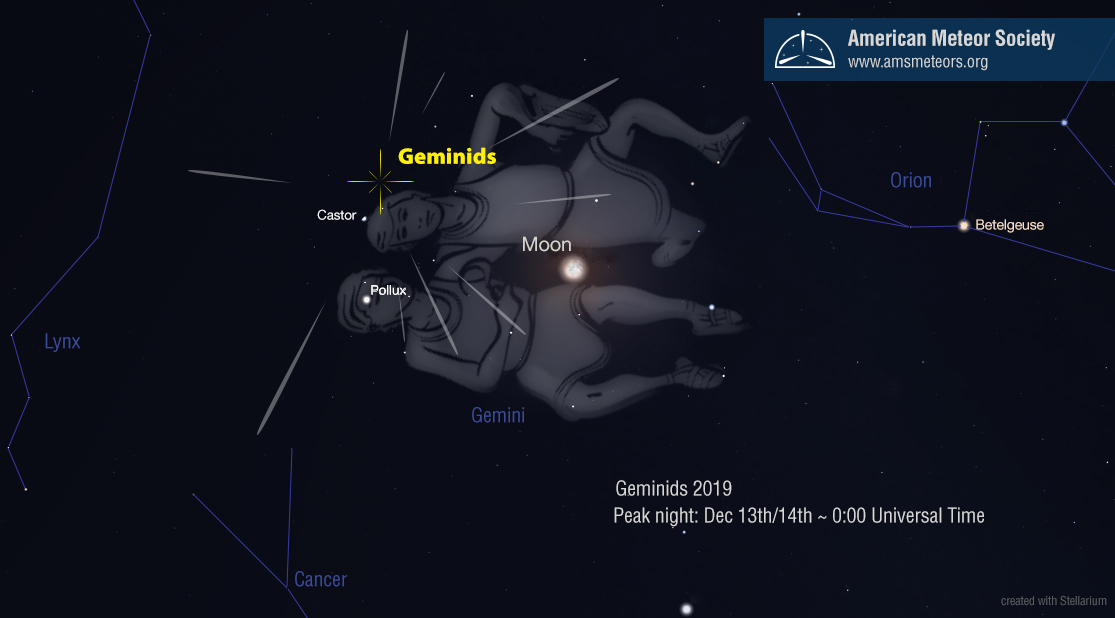
Canon EOS 5D Mark II, 50.0 mm, ISO 3200 – composite
The most dependable meteor shower
Year in and year out the Geminids are currently the most dependable meteor shower. Unfortunately, they are active in December when temperatures are often cold and skies cloudy in the northern hemisphere. This year however, there will be a nearly full moon in the sky as the Geminids peak on the night of December 13/14. Unfortunately this means that the fainter meteors will be obscured by the bright moonlight and that total counts will be reduced drastically.
Then is this display worth viewing this year? Most certainly! So it may be chilly out, but if you bundle up and step outside over the next week, you’ll be able to enjoy one of the most active meteor showers of the year! Instead of seeing 60 or more Geminids per hour one may still be able to count roughly 20 per hour. Is 20 per hour worth viewing on a cold December night? If you look at the overall activity throughout the year, only 10-20 nights per year can match this total. And since the most of the meteors you will see under such conditions will be bright, they will be more colorful and impressive than usual.
An Asteroid as parent body
Unlike most other meteor showers, the Geminids are not associated with a comet but with an asteroid. 3200 Phaethon is an asteroid with an orbit that brings it closer to the Sun than any other named asteroid (though there are numerous unnamed asteroids with smaller perihelia*). For this reason, it was named after the Greek myth of Phaëthon, son of the sun god Helios.
Even though 3200 Phaethon is classified as an asteroid, it often acts like a comet by ejecting dust when it nears the sun. The Earth is near the orbit of 3200 Phaethon during the first three weeks of December. It comes closest to the core of the orbit on December 14th each year. This is the date most Geminid meteors are encountered and seen. When the Earth is near the edge of the orbital debris of the asteroid, little activity is seen.
* The perihelia is the point in a solar orbit where the orbiting body is closest to the sun.
Unlike most meteor showers, the activity curve is asymmetrical. The climb to maximum activity is slower than the fall. Geminid activity is impressive for several nights prior to maximum but drops off quickly after December 14th. This phenomena can been seen in the graph below that represents the Geminids 2018 activity (ZHR), based on visual observations reported by citizen scientists through the online report form of the International Meteor Organization (IMO) built by the AMS.

So when and where do I look?
To best see the Geminids you need to view as close to December 14th as possible. Like all meteors showers, there are many more faint meteors than bright ones. Eyes that had just stared at the moon or just came outside from indoors will not be able to see these fainter meteors. Give your eyes time at adjust to the darkness. It is also advisable to watch for as long as possible as meteor activity waxes and wanes throughout the night. There will be periods when little activity is seen and then other periods when meteors are falling constantly. These periods often last as long as 15 minutes so it is advisable to watch for an hour or more so that you witness several peaks and valleys and get a real feel of the meteor activity.
In order to view for that long, you need to be comfortable so a lounge chair is recommended. Lie back and view at a 45 degree (halfway up) angle to see the most activity. In the northern hemisphere be sure to have a blanket (hot beverages recommended!). You can face in any direction as Geminid meteors can be seen in any part of the sky. No matter what part of the sky they appear, they will all trace back to the radiant near the bright star known as Castor.

You don’t have to know where Castor is located, but you will soon learn as meteor after meteor will shoot forth from that direction. This year, you can also rely on the Moon to find the Gemini constellation. Another item you will discover is that not all meteors will be Geminids. You will see some meteors, both faster and slower than Geminids, travel toward Gemini and in many other directions. Most of these will be random meteors that don’t belong to any recognizable shower. Some of the others will belong to minor showers that produce only a few meteors per hour.
What if it’s too cloudy or too cold outside?
Well, in this case, stay tune: the AMS will provide a live coverage of the shower thanks to the AMS AllSky6 Camera network! Follow us on Facebook or Twitter for more info.
 American Meteor Society
American Meteor Society
Well done
Thank you for sharing your knowledge with us and I will be looking up in the sky around the 13-16
Looking forward to seeing this.
Our Famous, Local Weather Anchor at WCVB-Channel 5-Boston reminded Us about the Germinid Showers on Thurs. night, he said there May be a few this weekend before the Real Beauty comes on Lucky Friday, the 13th of December!!
So I just happen to look out my window
Early on December 7th, 2019, @ 1:30 AM and saw a Very Clear Meteor With An Awesome Colorful Trail behind, within 10 minutes, saw another, and a few that were Harder to See!!!
So if Last Night Was Like the ”Intro,” to Awesome Germinids,…Then Next week Should Be, a
“Best Seller!!”
HAVE FUN WATCHING, STAR GAZERS!!!
MAY THE FORCE BE WITH YOU ALL!!
Merry Christmas & Happy Holidays!!
⛪️
Never saw one. Hope to be awake. Live in Soap Lake Washington. Thank you for sharing
Just stepped outside with my dogs tonight (Dec. 11) in Jefferson, GA at around 11pm, and was immediately startled by a very bright orange-ish flash of light that streaked across the sky, faster than anything else I can remember seeing. I watched for a little while longer, but though I saw far more aircraft activity than usual, I didn’t see any other meteors.
What would be the best time to be outside for the shower in St Louis Missouri
Deborah and All,
No matter your location you will see the most activity between 1am-3am on December 14th.
I have seen 4 over the past few days; two of those were seen tonight. I was walking into Epcot with my husband at dusk, looked up, and saw one streaking across the sky with an unusual angle to it. It looked like tiny comet with a tail. I have never seen anything like it!
Really velueable contain
Thanks for information